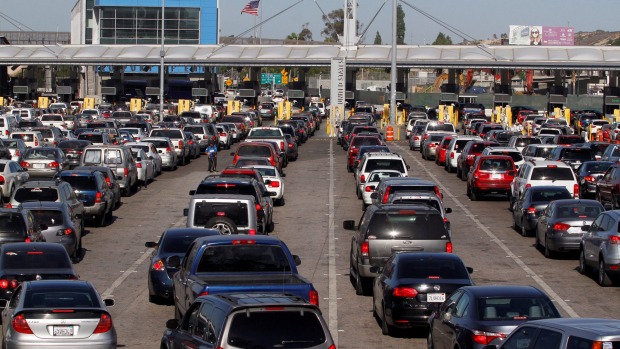It’s the biggest land port of entry in the western hemisphere.
To the south, a gargantuan cluster of cars and buses in a 10-lane-plus bottleneck head north towards the US town of San Diego.
Passengers could be kept waiting for hours to cross into the border into the US.

Mexicans on the Tijuana side can approach the border fence at any time but the US Border Patrol, however, tightly controls the San Diego.
Yet heading south into Tijuana, it is very easy to cross the border into Mexico. A 30-minute tram ride takes you from downtown San Diego to the border at San Ysidro where it’s a quick interview, a stamp on the passport and you’re in.
Across the other side, touts sell tacos and taxi rides for US dollars as you cross the pedestrian bridge which overlooks the lines that snake back into the US, full of both Americans and Mexicans who found a cheaper way of living in Tijuana but still cross daily to earn US dollars in San Diego.
The US and Mexico have had a long history of living closely together, with many crossing the border to good-time girl Tijuana – first during America’s prohibition era, later, sailors, cheap holidaymakers and under 21s.
Tijuana’s main street – Revolucion – is lined with bars, clubs, and souvenir stands that once catered to these people, fuelling the local economy.
In 2008, all this changed when drug-related violence hit Tijuana hard, and the once busy streets of Tijuana emptied as American tourists no longer believed it was safe. They also lost the sailors from San Diego’s Navy base, who were forced to take their recreational drinking breaks elsewhere.
Soon after, a US-funded expansion project saw the chain link fence separating the two countries disappear and replaced by something a little more convincing. In the San Diego area alone, the border has not one but three sections. A system of uninterrupted barriers continues to divide the two countries across the rest of the continent.

US Border Patrol agents on horseback patrol along a beach just north of the US-Mexico border near San Diego, California.
No expense has been spared; further east, at a cost of six million dollars per mile, a remarkable seven mile long ‘floating fence’ has been constructed to sit on the top of pristine desert sands. When the migrating sand dunes begin to bury the 15-foot tall fence, it can be lifted and repositioned by a machine.
In Tijuana, the eyesore can be viewed from the main highway which follows the fence across hilltops and through valleys, a constant reminder of just how unwelcome unwanted visitors are. It looks, and feels, like the perimeter fence of a jail.
The highly visible fence accompanies Mexico’s rusty iron bars which Trump wants replaced with «an impenetrable, physical, tall, powerful, beautiful, southern border wall» – and he’s sending the bill to Mexico.

A woman on the Mexico side chats with relatives.
Estimates have the fence costing, at the absolute minimum, US$10-12 billion, but a Washington Post article has estimated the cost at $25 billion. In order to build, private land might be confiscated. It would also have a huge environmental impact.
And how would Mexico be forced to pay? Trump has suggested he could ransom the country by blocking illegal immigrants from sending money home, increasing visa application fees and charging more for border crossing cards, used by regulars to fast track border crossings.
Meanwhile, back in Tijuana, artists from both sides of the fence are working on making sections of the Mexican wall as invisible as possible.
In 2012, and dressed in a black cocktail dress and heels, Mexican artist Ana Teresa Fernandez, set about ‘Erasing the Border’. She climbed a ladder against a section of the 18 foot high fence along Tijuana’s beach and painted it a shade of blue that matched it surrounds, so at certain angles, it seemingly disappears.
Enrique Chui is another artist working on making the «ugly, rusty wall» invisible. He’s in the process of creating a mural that stretches for around 20 city blocks. Around 800 artists from the US and Mexico have signed up to help paint the mural. They’re not allowed to paint on the US side. And if Trump builds another wall «we’re going to paint it,» Chui says. «It’s another canvas.» Tijuana has steadily become a hub for artists, who have also drenched Tijuana city’s walls in street art.
Across in San Diego, in early May, locals are preparing for a huge annual Mexican festival – Cinco de Mayo – a festival created for Americans, by Americans, celebrating Mexican culture, that’s taken off up the West coast.
The celebrations are based in Old Town, the birthplace of California – settled by the Spanish, who built adobe buildings for the Mexican community and called it El Pueblo de San Diego. In 1848 Mexico ceded California to the US.
Tonight, on the eve of Chinco, stars twinkle overhead from the open-air cantina, where friendly staff bustle about manoeuvring huge plates of tacos, enchiladas and fajitas, warm tortillas and corn chips, while maharachi players serenade guests sipping frozen fruity Margarita bowls the size of their heads. Ladies dressed in traditional costume churn out freshly made tortillas the scent of which fills the air, as it does across the border. I tell the girl sitting at the table next to me I’d just visited Tijuana, and she’s alarmed. «My friends all told me not to go,» she said «they say it’s too dangerous!»
Meanwhile, the people of Tijuana have found another way to address the battle scars left by the drug-related crime of 2008. They realised that they could no longer depend on tourists and had to find a way to be self sufficient – which, for this former hotbed of sleaze, turned out to be not such a bad thing.
The result is a city with a very different centre. Although the bars along Revolucion remain, there’s something else drawing people back to its streets.
There’s microbreweries, coffee shops, and hip alleyways filled with tiny restaurants serving southern comfort food like po boys and gumbo. There’s record stores, vintage knick-knacks and hipster t-shirt designers. Not to mention the street art, which is everywhere.
But the most impressive change it has made is its culinary scene, spurned by the addition of a culinary art school in Tijuana. If there’s anything that can lure American tourists back, it’s food, wine and craft beer.
It’s tiny town centre has at least two upmarket food truck parks that would not look out of place in Melbourne, in one instance, or Austin, in another.
We stop by one just out of downtown which has an unusual mix of some seriously talented chefs churning out some of Tijuana’s best cuisine. One’s insanely rich chocolately mole is some of the best I’ve tasted. Otto, a local fisherman serves up traditional Mexican seafood dishes from his truck. There’s a cheese truck – order a platter piled high with cheese made with olives, habanero, cranberry or herbs, and a delicious stringy Oaxacan. And local celebrity chef Javier Plascenia churns out meaty tacos while you sip local beers and wines in a shady courtyard.
Close by, the smell of hops wafts from the front door of Norte Brewing Co which has a great view of the town and five of its beers on tap.
And if it’s more traditional Baja Californian food you are craving, you can always head to the colourful, old school seafood stalls which line the malecon alongside Playa de Tijuana, a huge stretch of beach distinguished by the great rusted, art-covered barrier that separates it from San Diego’s Border Field State Park.
«One day we hope the fence will no longer be there» my guide explains, motioning to the section that has been painted ‘invisible’.
I’d like to bet Donald Trump would have something to say about that.Puesto at the Headquarters in Downtown San Diego; award winning food in modern surrounds, Puesto puts a modern twist on Baja Californian cuisine. eatpuesto.com
Puesto at the Headquarters in Downtown San Diego; award winning food in modern surrounds, Puesto puts a modern twist on Baja Californian cuisine. eatpuesto.com
Touring Tijuana
Tourista Libre run organised or bespoke guided tours of Tijuana; see turistalibre.com





